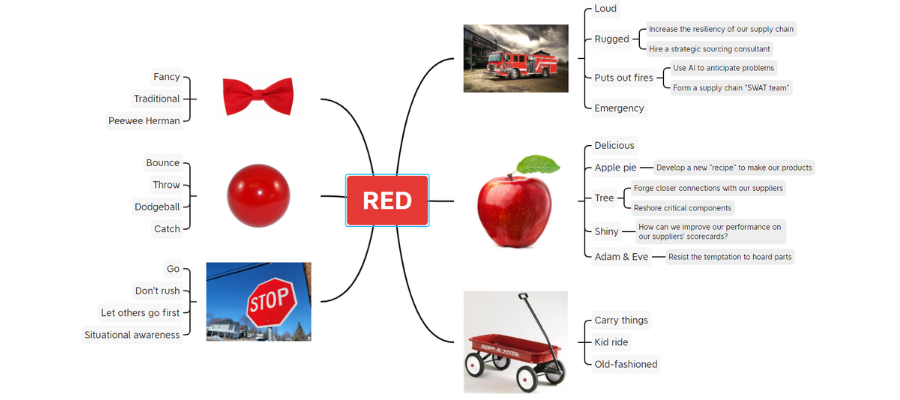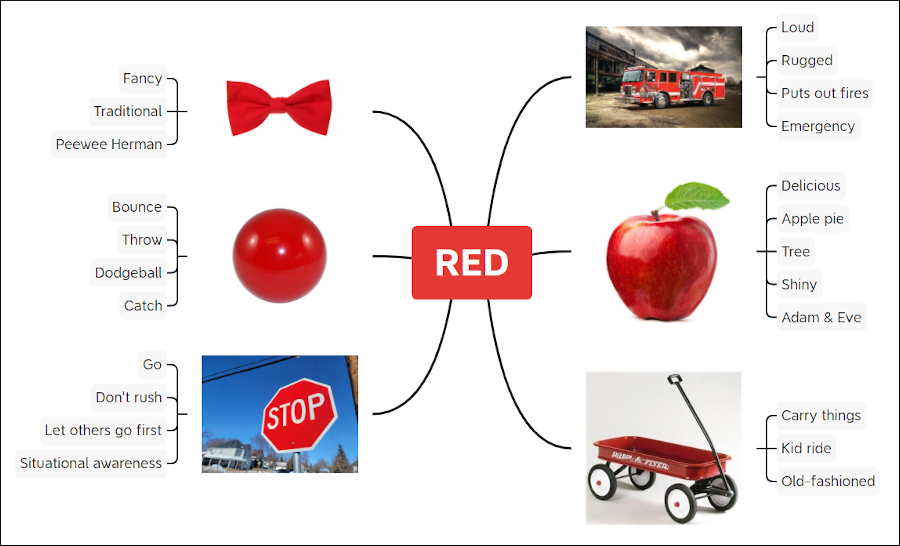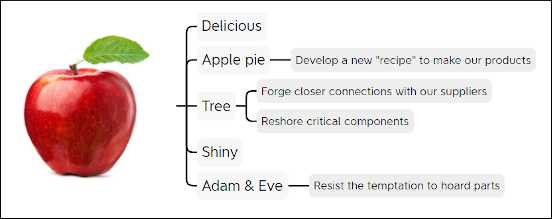
Have you ever needed to solve a problem, but your brain lacked creative energy? If so, then maybe it’s time to try a fresh approach.
One way to do that is to create an image map – a mind map containing random images. You can then use the words and concepts they suggest as stepping stones to generate valuable creative solutions.
Why this approach works
Images are powerful tools for brainstorming because they activate a different part of your brain than words do. Evocative images can help you think in new directions. Combine images with mind maps and you’ve got a winning combination!

To help you understand how this works, I created an example that I’d like to show you. Let’s say my company is facing supply chain issues – a common scenario for many manufacturers today. My company can’t get enough parts from its suppliers to keep its production lines running. I need a creative solution – and fast!
I tried traditional brainstorming, with limited success. All it yielded were some boring, tired ideas. Nothing inspiring.
I need some radically different inspiration and solutions.
4 steps to build an image map
Here are the steps I followed, to create a unique type of mind map that uses images as creative stimuli. I used XMind 2021 to build it because it allows me to create topics that are images only – no text is required:
STEP 1 – Select a random word for the foundation of your mind map: This word doesn’t have anything to do with your current challenge. Your goal is to take a temporary creative excursion AWAY from your problem or challenge, brainstorm a list of unrelated words and concepts, and then look for ways to connect them to it. This is a powerful technique to generate truly divergent ideas that you wouldn’t have considered otherwise.
For my image map, I chose the word “red” and placed it at the center of a new mind map.

STEP 2 – Brainstorm associations based on your central topic. Find images that represent them (I used Google image search) and drag them and drop them into your mind map as first-level topics. For the concept of “red,” I added these six topics:
- Fire engine,
- Apple,
- Coaster wagon,
- Stop sign,
- Red rubber ball, and
- Bowtie.
In XMind, I had to first create a new branch, drag and drop an image to it and then delete the default text it adds to new topics as a placeholder (e.g., “topic 1,” “topic 2”). As a final step, I changed the topic background color to white so it would blend in with the color of the map background. This gave each image a cleaner appearance.
At the end of step 2, you should have a vibrant, colorful mind map that only contains one word or idea – the central topic. The rest should be composed of images only.

STEP 3 – Ask yourself, “What words, ideas, qualities or concepts do these images suggest?” Add them as subtopics to your mind map. The more, the better!
For example, for the image of an apple, I added the words:
- Delicious,
- Apple pie,
- Tree,
- Shiny, and
- Adam and Eve.
All five concepts are radically different, but all are related to the concept of a red apple.

STEP 4 – Use these new word associations to brainstorm solutions to your challenge. Add them to your map as sub-sub-topics. Don’t censor yourself at this stage of the process. Record every idea, no matter how ridiculous it may seem. If a word or phrase doesn’t immediately suggest any ideas or potential solutions, go on to the next one.
 In the image at right, you can see how I’ve done that with the image of the apple and the keywords I brainstormed in step 3. For example, the phrase “apple pie” suggested recipes to bake them. That, in turn, got me to wondering, “What if we developed a new ‘recipe’ to build our product that doesn’t rely on the material that’s currently experiencing shortages?”
In the image at right, you can see how I’ve done that with the image of the apple and the keywords I brainstormed in step 3. For example, the phrase “apple pie” suggested recipes to bake them. That, in turn, got me to wondering, “What if we developed a new ‘recipe’ to build our product that doesn’t rely on the material that’s currently experiencing shortages?”
Likewise, the keyword “tree” got me thinking about my company’s supplier relationships. If I focused on improving them, perhaps they’d be more likely to consider my company a first tier partner when shortages occur.
Finally, for the concept of Adam and Eve, I added the idea of avoiding the temptation to hoard or stockpile parts or materials from my suppliers. Easier said than done when a crisis hits. But hoarding is one of the behaviors in supplier-manufacturer ecosystems that causes shortages in the first place. If I do my part and don’t hoard, perhaps parts availability will return to normal faster.
A visual antidote to brutethinking
Do you see how this works? Most people “brutethink” problems. In other words, they try to tackle them straight on. Often, that results in ideas and solutions that are of limited value. To generate more innovative solutions, you need to think divergently, laterally – in different directions than you’re accustomed to..
This simple, visual brainstorming exercise, using random keywords and images, is the perfect antidote to brutethinking and could be the perfect stepping stone to a truly novel, valuable solution.
Why not give it a try?

Leave a Reply